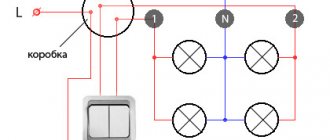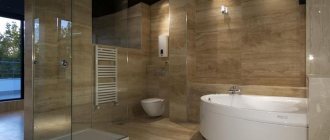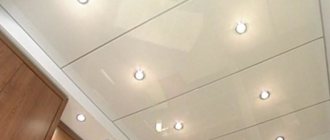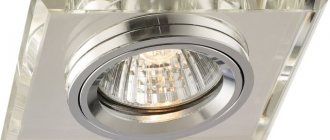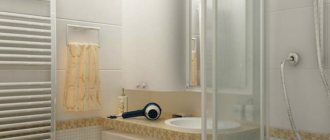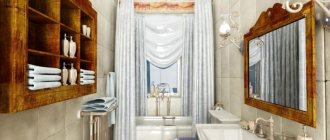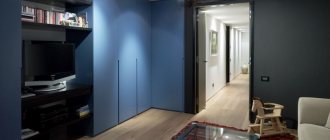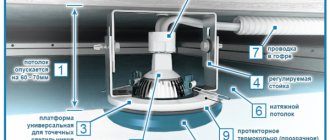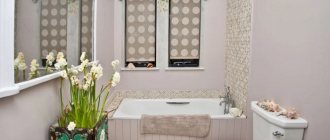Bathroom lamps in Moscow
Bathroom lamps and other products can be purchased at Leroy Merlin in Moscow at low prices. Select the product you are interested in on the website and buy it in our online store. The range of products presented in the catalog is extremely wide. Among them there will certainly be a position suitable in all respects.
All products presented in the “Bathroom Lamps” section are produced by well-known companies that have proven themselves to be of high quality for their products.
You can always place an order and pay for it online on the official website of Leroy Merlin in Russia. For residents of the Moscow region, we not only have low prices for products in the “Bathroom Lamps” category, but also fast delivery to cities such as Moscow, Balashikha, Podolsk, Khimki, Korolev, Mytishchi, Lyubertsy, Krasnogorsk, Elektrostal, Kolomna, Odintsovo, Domodedovo, Serpukhov, Shchelkovo, Orekhovo-Zuevo, Ramenskoye, Dolgoprudny, Pushkino, Reutov, Sergiev Posad, Voskresensk, Lobnya, Ivanteevka, Dubna, Yegoryevsk, Chekhov, Dmitrov, Vidnoye, Stupino, Pavlovsky Posad, Naro-Fominsk, Fryazino, Lytkarino, Dzerzhinsky, Solnechnogorsk, Istra and Zhukovsky.
Bathroom lighting
In our online store you can find many options for a variety of lighting fixtures that can be used in the bathroom despite humidity, condensation, splashes of water and temperature changes.
To protect your family from short circuits and buy a durable lamp for the bathroom, we recommend that you pay attention to the range of products with a moisture-proof coating, which are available in a wide variety in our online store.
LED bathroom lights moisture-proof ceiling
Products of this type of lamps are produced in huge quantities. It is quite difficult to choose the most economical and safe one from the proposed options.
LED lamps can be divided into groups:
- Location – ceiling, wall;
- Room - bathroom, bedroom, living room and so on;
- Shape – round, oval, square, rectangular;
The newest and most reliable option is a built-in matrix of several LEDs instead of a conventional lamp. The use of spot LEDs in bathrooms requires a high level of room lighting. It is also important to decide on the color of lighting that will be closest to natural light. When choosing LED products, give preference to lamps from trusted manufacturers.
Mistake 1. First beauty, then safety
When choosing light in the bathroom, use the principle of safety first, then everything else. No matter how beautiful the sconce is, it is not suitable for the bathroom if its protection index against moisture and dust is 0.
IP index on the packaging, photo example
Index of protection of the lamp against dust and water
The IP index consists of two numbers - IP 44. The first number (from 0 to 6) is the degree of protection against the ingress of solid particles (dust), the second (from 0 to ― protection from the ingress of liquid. The higher the number, the higher the protection. See the value on the packaging, lamp body or in the product characteristics in the online store.
protection from the ingress of liquid. The higher the number, the higher the protection. See the value on the packaging, lamp body or in the product characteristics in the online store.
The more IP a bathroom fixture has, the better.
Decoding the IP index for luminaires on the diagrams
Bathroom luminaire placement area based on IP
The choice of IP index for a lamp depends on where you install it - that is, on the location area.
- zone 0 - moisture enters directly by stream (bottom of the shower stall, bath screen, etc.);
- zone 1 - moisture often splashes (the wall of the shower stall, walls near the sides of the bathtub, etc.);
- zone 2 - moisture splashes infrequently (60 cm from the sides of the bathroom, behind the shower doors, etc.);
- zone 3 - moisture enters very rarely or never (near the ceiling, etc.).
From here it becomes clear that the sconce near the mirror should have a min IP index of 44, and the built-in lamp in the bottom of the shower should have a min IP index of 67.
Safe and unsafe zone for placing a lamp in the bathroom, taking into account the IP diagram
Which provides protection from steam and moisture
The moisture-proof lamp is equipped with additional gaskets and seals that prevent water from getting inside.
You can find out the degree of protection of a lamp by the protection index – IP, which is indicated in the labeling. IP is a two-digit European humidity standard. The first number indicates the degree of protection of the device from the ingress of dust and solids, and the second is responsible for the ingress of moisture.
Dust protection:
- IP – 0: the lamp is not protected from dust;
- IP – 1: the lamp is protected from large particles larger than 5 cm;
- IP – 2: protection against particles larger than 1.2 cm;
- IP – 3: average value that protects the lamp from particles larger than 2.5 mm;
- IP – 4: protection against foreign bodies larger than 1 mm;
- IP – 5 and IP – 6: this is ideal protection against dust; with these values, foreign bodies do not get inside the lamp.
Moisture protection:
- IP – 0: no protection from moisture;
- IP – 1: protection against drops of water and condensation falling from above;
- IP – 2: option for the bathroom, drops do not fall into it at an angle of 15 degrees;
- IP – 3: protection against drops falling at an angle of 60 degrees;
- IP – 4: protection against any splashes;
- IP – 5: protection against drops and jets of water;
- IP – 6: resistance to sea salt water;
- IP – 7: resistance to immersion in water to a depth of 1 m;
- IP – 8: perfect tightness, moisture does not enter even at great depths.
The choice of one or another lamp is determined by the humidity zone in the bathroom.
The difference between waterproof lighting fixtures and conventional ones
At first glance, it is difficult to distinguish moisture-resistant devices from ordinary ones. The main differences lie not in the appearance of different types of devices, but in their internal details. Moisture-resistant lamps are equipped with additional elements, the main task of which is to protect the socket, terminals and electronic unit from moisture penetration.
Under no circumstances should water get inside the lampshade. Therefore, the first factor that you need to pay attention to when purchasing is the presence of sealing rubber at the joints between the lampshade and other parts of the device. It is also necessary to have special waterproof plugs located at the wiring input into the housing.
Moisture resistance is a quality that is not characteristic of ordinary lamps. Therefore, resistance to moisture is always indicated in the accompanying documentation (technical data sheet), as well as on the packaging.
Waterproof bathroom spotlights
The system that classifies lighting fixtures according to their level of protection against ingress of liquid and solid materials according to international standards is called IP. The numbers following the abbreviation indicate the level of penetration of liquid and solid substances. Spotlights can be installed in the house in the ceiling or wall, in the ground on the street. They have protection only from the front side. Therefore, care should be taken to prevent moisture from entering from the inside of the ceiling. Transformers should only be 12 volts. It is not recommended to buy lamps operating at 220. There is a huge probability of a short circuit resulting in a fire or electric shock. But still spotlights are very popular.
What are their advantages?:
- Protection against the impact of current and water with each other;
- Visually enlarge the room;
- Places emphasis on a specific item, distracting from the shortcomings of the room;
- The light of such a lamp mentally relaxes and calms the eye.
There are not many disadvantages, but they are still present. For certain types, additional equipment is required. There is no way to place such lamps in a low room without a suspended ceiling installation.
Based on their mounting, spotlights can be divided into flexible (spotlights) and non-flexible ones. Soffits can be controlled manually by changing the direction of the light. The design is much more expensive and is often not suitable for a bathroom. The best option would be clumsy lamps. The combination is adjusted according to the scheme, illuminates the entire necessary area, but more lamps need to be used. Halogen and fluorescent lamps require less energy but last a long time. LED lamps are the most convenient, but very expensive lamps. Consume up to 6 watts per m2. Diodes usually act as an addition; they are used for decorative purposes and zoning.
Mistake 2. Not taking into account the furniture arrangement plan and bathroom interior
It doesn’t matter whether you select lighting in the bathroom at the renovation stage (which is best) or in a finished apartment - do it taking into account the arrangement of furniture, total area, layout and color combinations. So, it is immediately clear how much working light is needed, whether there is a risk of dark corners, etc. For example, in a light bathroom with glossy tiles and an area of 8 m2, 4-5 ceiling built-in lamps (main lighting) and two sconces on the right and to the left of the mirror (working lighting). And in a bathroom with dark tiles, an area of 4 m2 and a sink in the corner, you will need more task lighting precisely because of the non-standard layout.
Non-standard bathroom layout with a sloping wall, photo example
Standard small bathroom layout
Before buying bathroom fixtures, think about the following:
- non-standard shape and area of the bathtub;
- interior color, whether there are reflective surfaces or more matte ones;
- and how much work light, main light or decorative lighting is needed;
- personal needs (are there elderly people in the house, a mirror in the bathroom instead of a dressing table, etc.).
How to choose bathroom fixtures
Bathroom lighting fixtures must be protected from moisture. This is the main selection criterion; in addition, the type of lamp, its power and color temperature are important.
The number of appliances depends on the size of the bathroom. For a small room, a ceiling lamp and lighting near the mirror will suffice. In a spacious room you can place four or five types of devices.
Set of lamps
ics for a large bathroom could be, for example, like this:
- ceiling: spotlights plus LED strip around the perimeter;
- walls: sconces on both sides of the washbasin;
- furniture: mirrored cabinet with lighting, shelves with LED strip along the bottom edge, miniature lamps with motion sensors inside the cabinets.
The most important point: all lamps must be protected from water vapor, condensation and splashes. Those located on the floor also protect against possible flooding.
Water protection
| The packaging of each lamp must bear the international IP marking. IP is an abbreviation for Ingress Protection, “protection from the outside.” Indicates the level of protection of the device from external influences. The first number after the letters IP indicates how the lamp tolerates exposure to dust, the second - moisture. The higher the numbers, the better the dust and moisture protection. In addition to the letters I and P, you can also find other Latin letters on the packages. They indicate the degree of protection against contact. For example, A means that the device is safe to touch with the back of your hand, B means it is safe to touch with your finger. This information is relevant only for open structures, that is, for lamps that are not covered with shades. |
IP protection classes
| Example. IP68 protection class means that the lamp is not afraid of either dust or water. It can be installed, say, on the ceiling above an open shower stall. Safety requirements for luminaires in different zones.
|
|
Illumination
| The illumination standard for the bathroom (it is prescribed in SNiPs) is 50 Lux. Illumination is measured in lux. 1 lux is 1 lumen per 1 sq.m. Lumen is a luminous flux, this value is indicated on each light bulb. |
| Example. Let's calculate how many light bulbs will be needed to illuminate a bathroom measuring 9 sq.m. We multiply the norm according to SNiP by the area of the room - 50x9, we get 450 Lm. 80-90% of this flow should come from general, ceiling lighting. You can choose, for example, two LED ceiling lights of 2-3 W (about 250 Lm each). For the bathroom, we recommend using two types of light bulbs, LED and halogen. Important: only LEDs can be used for suspended ceilings. The power of halogen lamps in the bathroom should not exceed 35 W and the voltage should not exceed 12 V. |
| |
Approximate ratio of power and luminous flux of lamps
Halogen bulbs themselves are cheaper than LED bulbs, but LEDs are more reliable and more economical to use. For comparison: the working life of a halogen lamp is up to 2000 hours, and an LED lamp is up to 25,000 hours.
Comparison of halogen and LED lamps |
| Advice. When installing a halogen light bulb, hold it with a cloth or gloves. Afterwards, the flask must be thoroughly wiped with a cloth and alcohol. It is important to use a fabric that does not leave lint on the surface, such as microfiber. |
Colorful temperature
Lamps can produce warm, neutral or white light. It is perceived differently: for example, warm light creates comfort, cold light helps to concentrate.
In the area where the bath is installed, we recommend using warm light, it helps to relax. For other areas, lighting of a neutral shade is suitable. Cool white light is also acceptable for illuminating the shower stall.
| Color temperature is measured in Kelvin: |
By the way, you can buy light bulbs that can change color temperature. Such devices are controlled using a remote control or a regular wall switch: the temperature changes every time the key is turned on.
Address tape in the bathroom interior | For illumination, you can use not only white, but also single-color (for example, blue or green), regular or addressable RGB LED strip. Plain and multi-colored tape is used to illuminate the ceiling, shelves and niches. The RGB tape can change color; using the remote control you can choose any shade, be it soft pink or bright purple, or set the color change. Address tape is most often used to illuminate the ceiling; it can be used to create complex color transitions. |
The influence of layout and design on the choice of lamp
The choice of lamps is influenced by at least six factors:
|
For a bathroom with high ceilings, a chandelier or pendant in the center of the ceiling is suitable. For rooms with low ceilings, it is better to use built-in or overhead spots.
Consider the height at which the ceiling lights will be located. The lower they hang, the brighter and more focused light they produce.
Dark surfaces absorb light, light surfaces reflect. A bathroom with walls covered in dark gray matte tiles requires more powerful fixtures than a room with a white glossy finish.
The design of lighting fixtures should either be as neutral as possible or match the overall style of the bathroom.
| Lamps for different interior styles |
Lighting levels
Ideally, lighting should be three-level:
|
| The following may be responsible for general lighting:
If you have a suspended ceiling, you can install a “star scattering”. These are many LED dots that are installed under the canvas, creating the effect of a sky strewn with stars. |
| The work area is a washbasin and a mirror next to it. The lighting should be bright and at the same time diffused. Use sconces, LED strip, rotating spotlights or wall-ceiling lamps. The mirror needs to be illuminated symmetrically. It is important that the reflection is as natural as possible, without unnecessary shadows. The best option is lamps on the sides or around the perimeter of the mirror. Do not place lamps below face level. You can also choose a mirror or mirror cabinet with built-in lighting. There are heated models - condensation does not form on them. |
|
| Decorative lighting creates an atmosphere and helps set accents. Used to decorate pedestals, niches, steps, shelves and other elements. You can highlight everything, from the internal shelves of cabinets to the washbasin. |
General tips and life hacks
- Lamps in different functional areas should be routed to different keys of the same switch or to separate switches.
- Lamps located opposite the mirror provide almost twice as much light.
- You cannot install sconces above the bathtub - it is unsafe.
- In rooms with glossy tiles/mosaics, light should not be directed perpendicular to reflective surfaces, otherwise unnecessary glare will result.
- Lighting with a motion sensor, mounted inside cabinets, gives +100 to comfort.
- Floor lamps can visually expand the room. For floors, choose devices with a degree of protection IP67 or higher.
The Leroy Merlin team will help you select all the necessary materials - welcome to the Lighting section. On the site you can be inspired by ready-made bathroom interior solutions.
Mistake 3: Using only one light source
Usually the third error follows from the second. They installed a light in the bathroom, but didn’t think about the nuances.
Main and task lighting in the bathroom
Ceiling lighting (chandelier, lamps) provides general diffused light, which is convenient for taking a bath, but it is not suitable for shaving or applying makeup. Look at the picture below. Overhead light creates shadows on the face and highlights imperfections. Two wall lamps on the right and left or above the mirror will correct the situation (read about bathroom sconces here).
Main and task lighting in the bathroom, what is the difference?
General lighting is light that is evenly distributed over the entire area.
Working lighting - light near functional areas.
Power of bathroom fixtures: formula
The power of the lamps in the bathroom is the brightness of the illumination of the entire space. To correctly calculate the power, use the formula - type of light bulb (power consumption from the table below) * room area .
Formula for calculating the power of bathroom fixtures
*Lumen measures how much light you get from a light bulb. The more lumens, the brighter the light. The norm is 300 lumens per square. Read more about light bulbs in the following. point.
In practice it looks like this:
Bathroom area - 8m2
The power consumption of one incandescent lamp is 20 W.
8*20=160W - this is the amount of power needed to create comfortable lighting and 160 W - this is the total power for all lighting fixtures in the bathroom. That is, there are 4 of them, then 160/4 = 40 W - the power of each lighting device, if all of them have incandescent lamps.
Please note that results will vary for halogen, energy saving and LED bulbs. Use the formula we provided and you will quickly determine the necessary indicators.
IMPORTANT: The power calculation formula is suitable for bathrooms with ceiling heights below 3 meters. If the ceilings are higher, multiply the resulting power by 1.5. This is necessary because high ceilings “eat up” the light.
Example of dim lighting in a dark bathroom
An example of bright lighting in a bright bathroom
IP water protection ratings for bathroom fixtures
All bathroom fixtures must be waterproof with the recommended degree of protection IP44.
The maximum rating for a bathroom is IP67.
An even higher IP68 value is used for swimming pools and Jacuzzis, when the lamp is completely immersed in water.
For your room, such protection will be unnecessary.
Where to place this or that lamp depends on the safety zone. There are three of them in the bathroom.
In a wet area (bathroom itself, shower stall), installation of IP67 models is acceptable. Directly next to the bathroom - IP65.
In the second zone (from 30 to 60cm away from the wet area) – IP44. In this case, it is advisable to choose the supply voltage of such lamps not 220V, but 12-24V.
The third zone – everything beyond 60cm is acceptable IP24. However, here too it is recommended to choose models with a degree of protection of at least IP44.
When backlit with LED strip, it must also be waterproof with an IP-68 index.
Under no circumstances should open lamps be placed directly above the bathtub. This room is an area with sudden temperature changes and high humidity.
Even constantly running heated towel rails do not always save the situation.
Regular sockets are also prohibited here for safety reasons. And their installation is accompanied by a number of difficulties and problems.
When installing lamps, pay special attention not only to the tightness of the lampshade and housing, but also to the integrity of the sealing plug through which the power cable connects to the terminals.
Often, moisture penetrates inside and spoils the light source from here, and not through external splashes or drops.
Mistake 4. Not paying attention to the type of light bulbs in the lamp
There are several types of lamps: halogen, incandescent, fluorescent, LED, etc. It is the light bulbs in the lamp that determine how long they will work, how bright the lighting will be, etc.
| Lamp type/criteria | Incandescent* | Halogen** | Luminescent*** | LED**** |
| Safety | – | + | + | + |
| Electricity consumption | – | – | + | + |
| Price | from 42 rubles (+) | from 67 rubles (+) | from 350 rubles (-) | from 260 rubles (-) |
| Life time | up to 1000 hours (1.5 months) (-) | up to 2.5 thousand hours (3 months) (-) | up to 10 thousand hours (more than a year) (+) | more than 50 thousand hours (6 years) (+) |
| Brightness | – | + | + | + |
| Conclusion | + | ++ | +++ | ++++ |
* Incandescent lamps do not like humidity. Being very hot, it will burst if a few drops of water get on it. It flares up quickly, but produces a weak luminous flux. The incandescent lamp is the most power-hungry of all, but also the cheapest.
** Halogen lamps in terms of price/quality ratio are the most affordable and convenient option. They give a warm, diffused glow. They get hot, but not much. And they do not consume as much electricity as incandescent lamps.
*** The fluorescent lamp is completely safe in humid conditions. It produces a powerful luminous flux, but flares up in about 2 minutes, so it works better in combination with other types of lamps. It works silently.
**** LED lamps are the most economical of all. But due to voltage surges, they “clack”, creating unpleasant sounds. The downside is the high price.
A universal option for lighting in the bathroom is a combination of halogen and LED bulbs.
IMPORTANT : Halogen light bulbs for suspended ceilings must be covered with paint or a special coating on the reverse side. Thus, the platforms will not show through and create unsightly shadows in the stretch ceiling (see photo below).
Halogen light bulbs in the bathroom, photo example
LED light bulbs in the bathroom, photo example
TIP: Pay attention to the color of the halogen and LED lamps. Halogen ones give a warm light, while LED ones give a bright, white light.
Glow of halogen and LED light bulbs in the bathroom
Standards
International standards (in particular the ISO 8995 standard) require bathroom lighting to be at least 200 lumens per square meter. Based on the average indicators for lamps of different types - in the table below, you can select combinations of suitable power.
Light flow
The first digit of the interval is provided for a room with light surface finishes, the second - for dark ones. It turns out that for a bathroom with an area of 6 m2, it is enough to install one 100-watt incandescent lamp, or a 25-30 W fluorescent lamp, or 1 LED, with a power of 12-15 W, to obtain the required standard illumination of 1200 lumens. But it still makes more sense to use several low-power light bulbs located in the right places than one main lamp. This is especially true for small rooms - otherwise the shadowed corners are hidden, and the room looks even smaller.
An important requirement for lamps in the shower is increased tightness of the housing, connection points, as well as all the attributes necessary for the operation of the lamps (power supply, transformer, etc.). Pay attention to the IP marking (stands for Index of Protection) - the protection class of products; it should be no lower than 44 or 45. This means that such a lamp cannot be exposed to direct splashes of water and dust. The larger the second digit, the higher the degree of protection of the product from moisture.
How to choose lamps for the bathroom?
When choosing, we recommend being guided by the following criteria:
- Stylistics - models can be made in a modern style and will be perfect for high-tech, modern and loft interiors, or, on the contrary, in a more classic look, and then they will become an indispensable attribute for antique interiors;
- Installation method - lighting fixtures can be mounted on the ceiling or wall. Here, take into account the design features of the room.
- Zoning into functional areas - for example, you can hang several wall models above the mirror, others can be placed in the bathtub and dressing area.
Primary requirements
Requirements for lamps installed in the bathroom are usually divided into three groups: safety, brightness, design.
Safety
Since the bathroom is characterized by high humidity, electrical wiring must be completely protected. Lamps with a completely closed sealed housing are allowed. The device must be at a safe distance from water. According to GOST, this distance is at least 50 centimeters.
Brightness
The level of illumination in the room needs to be comfortable for humans. Cosmetic procedures are carried out in the bathroom (for example, applying masks or shaving), and therefore the light should be bright enough.
Light bulb power standards (W per square meter):
- light diodes (LED lamps) - from 6 to 9;
- incandescent lamps - from 20 to 30;
- halogen bulbs - from 23 to 28.
Advice! If the bathroom has a dark finish, it is recommended to choose more powerful light bulbs.
Design
A number of recommendations relate to the design of lighting fixtures. There is a wide variety of lamps on sale in different styles. The most popular solutions are:
- Classic style. The interior, made in a classic style, is associated with the use of natural materials (stone, wood, leather). This style is suitable for both a ceiling lamp (for example, a chandelier) and a wall lamp (for example, a sconce or spot). Classic solutions also include the use of forged products and crystal and bronze elements.
- Japanese style. The solution is distinguished by external calm and tranquility. The light from lighting fixtures is soft, slightly diffused. The shape of the lamps is often unusual, replete with complex outlines.
- Modern style. All design elements have some function. There are no parts that are useless from a practical point of view. Modern is more suitable when zonal rather than central lighting is organized. LED lighting is often used in this style.
- Provence style. This style requires the presence of a window in the bathroom. To organize sufficiently high-quality lighting, large chandeliers or floor lamps are used. Moreover, the light sources should resemble plants in their shape or finish. All forms are characterized by free lines, without geometric regularity.
Note! Plastic and glass products are more preferable than metal, as they are not subject to corrosive processes.
Mistake 7. Buy a chandelier/sconce with a dark shade and pattern
The material of the lampshade or floral shades can eat up the light power and convey the color of the light incorrectly. For example, a lampshade made of dark, light-retaining material reduces the level of illumination, which is most inconvenient in the bathroom, while many decorative details leave a shadow. Therefore, check immediately in the store how overly designer and decorative models transmit light.
Unsuccessful sconce for the bathroom, photo example
A successful example of a sconce for a bathroom, photo example
Types of lamps
In the space of the room, bathroom lamps are placed depending on the mounting option.
Floor-standing
In rooms with a large area, floor structures look impressive. They create a cozy and comfortable environment. Most often, the bathroom is decorated with a floor lamp with a lampshade made of plastic, crystal or glass (frosted, transparent, colored, etc.). Such devices should be placed away from water.
Lamps built into floor tiles
In stores you can find options for special, especially durable and moisture-proof lamps built into floor tiles. But the use of such equipment is justified only in spacious rooms. Due to space constraints, floor-standing devices are installed extremely rarely.
Wall mounted
Wall lighting elements are considered more popular. The following types of structures exist:
- Plafonds . Mounted close to the wall surface.
- Lampshades (sconces) on brackets . Sconces can be mounted on the walls even after the renovation is completed.
- Spot . Allows you to adjust the light spot.
Wall Light
Most often, wall lamps are installed near the mirror in the bathroom, as they better illuminate the face and create optimal conditions for performing hygiene procedures. They do not cause any particular difficulties in servicing, since they are within reach and do not require the use of a ladder or stepladder.
Types of Ceiling Lamps
Depending on the layout of the shower room, different spotlights are used: with an external socket, built-in or combined.
Ceiling light bulbs with an external socket (or overhead) are installed on “original”, simply plastered ceilings, in which there is no box, which means there is no way to place a hidden socket. This type of lamp is best used in rooms with low ceilings. Of course, they look more bulky, but still neater than ordinary hanging lampshades with light bulbs.
Recessed lamp
Their main advantage is that no boxes are needed, installation is simple - connect to hidden wiring and use it. Also, being located on an elevation, they allow you to cover a larger angle, which means they diffuse the light in the room more effectively.
Recessed (or recessed) ceiling lights are used when the room has a gap between the ceiling and the finishing material. Then all the unaesthetic technical “filling” is safely hidden in this opening. The ceiling covering here plays the role of an additional membrane that reliably protects the electronics from water.
It is preferable to use these models: firstly, because they look more neat; secondly, the cartridge and connections are mechanically protected by a coating (plasterboard, slats or film) from direct exposure to water (condensation);
Combined
and thirdly, the open design of the cartridge (located from the “wrong side”) facilitates the rapid dissipation of heat generated during the glow. This means that yellow circles from burning out due to constant heating will not appear on the surface of the ceiling over time. They are compact and durable, do not require any special care, since only the top part of the glass bulb looks out. This is the most common type of spot, which is used for different rooms.
Combined - they have absorbed the features of their predecessors - they are compact and cover large areas of the room with glow. They are often equipped with a rotating mechanism that allows you to change the direction of the light flow.
In addition, models with reflectors are offered, providing directional or diffused light.
The use of reflectors of complex design contributes to a multiple increase in the luminous flux emitted by the lamp. In this case, there is no additional waste of electricity. The result is significant savings achieved by passive methods - the design features of the lamps.
Mini-ceiling spotlights are also available. They are equipped with a rotating mechanism, so the light of the lamp can be directed at the desired angle with one movement.
Spotlight
